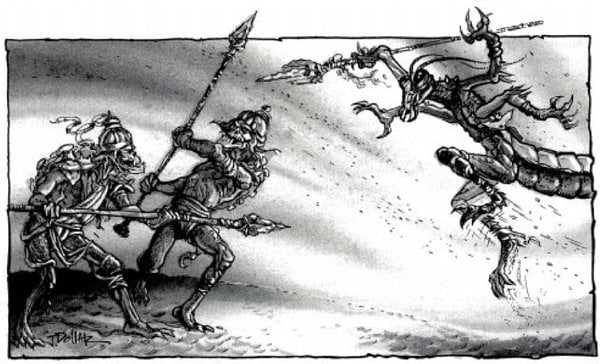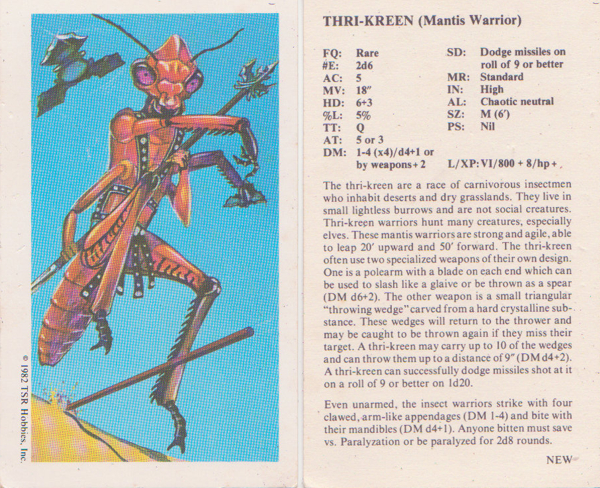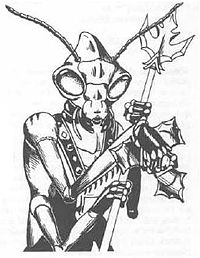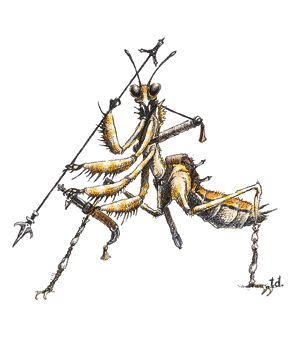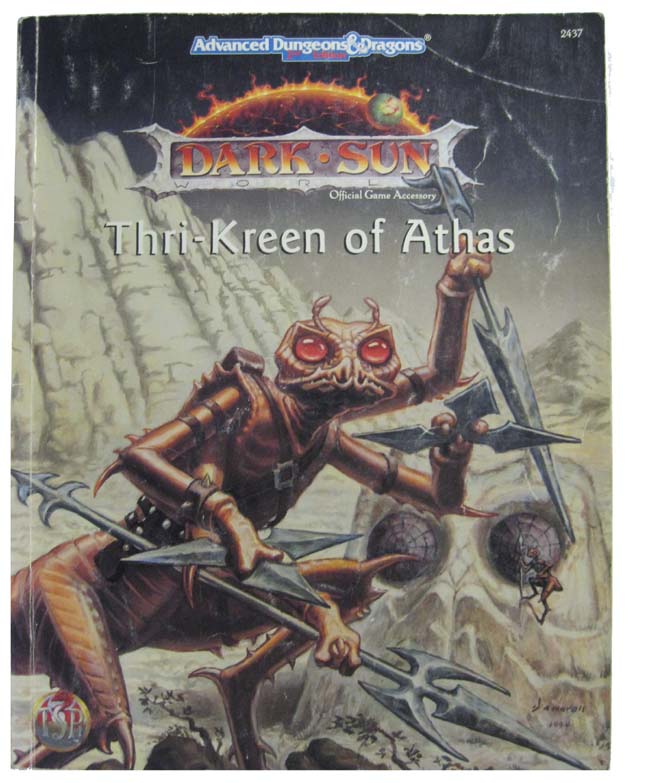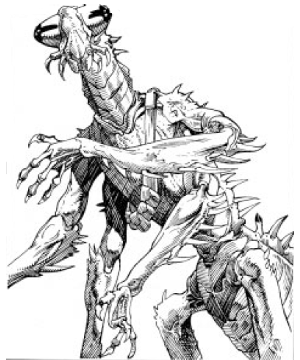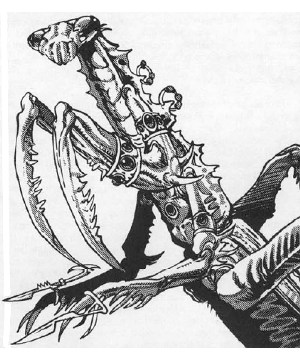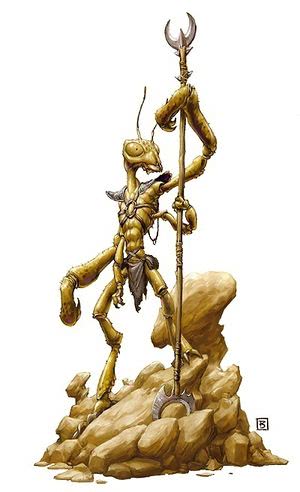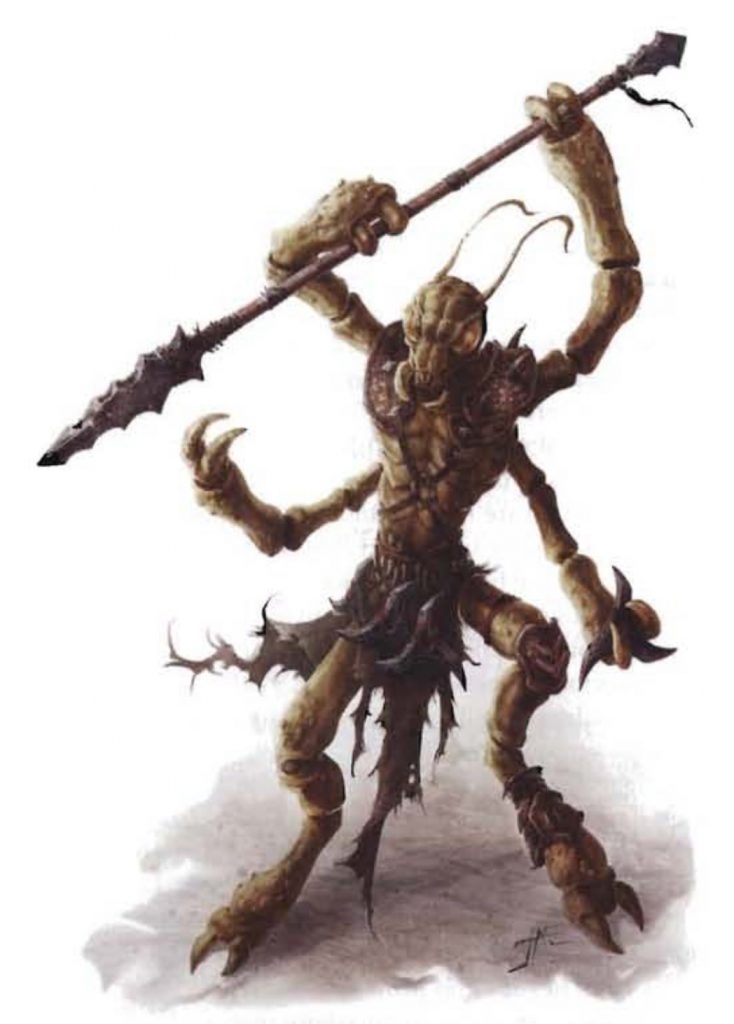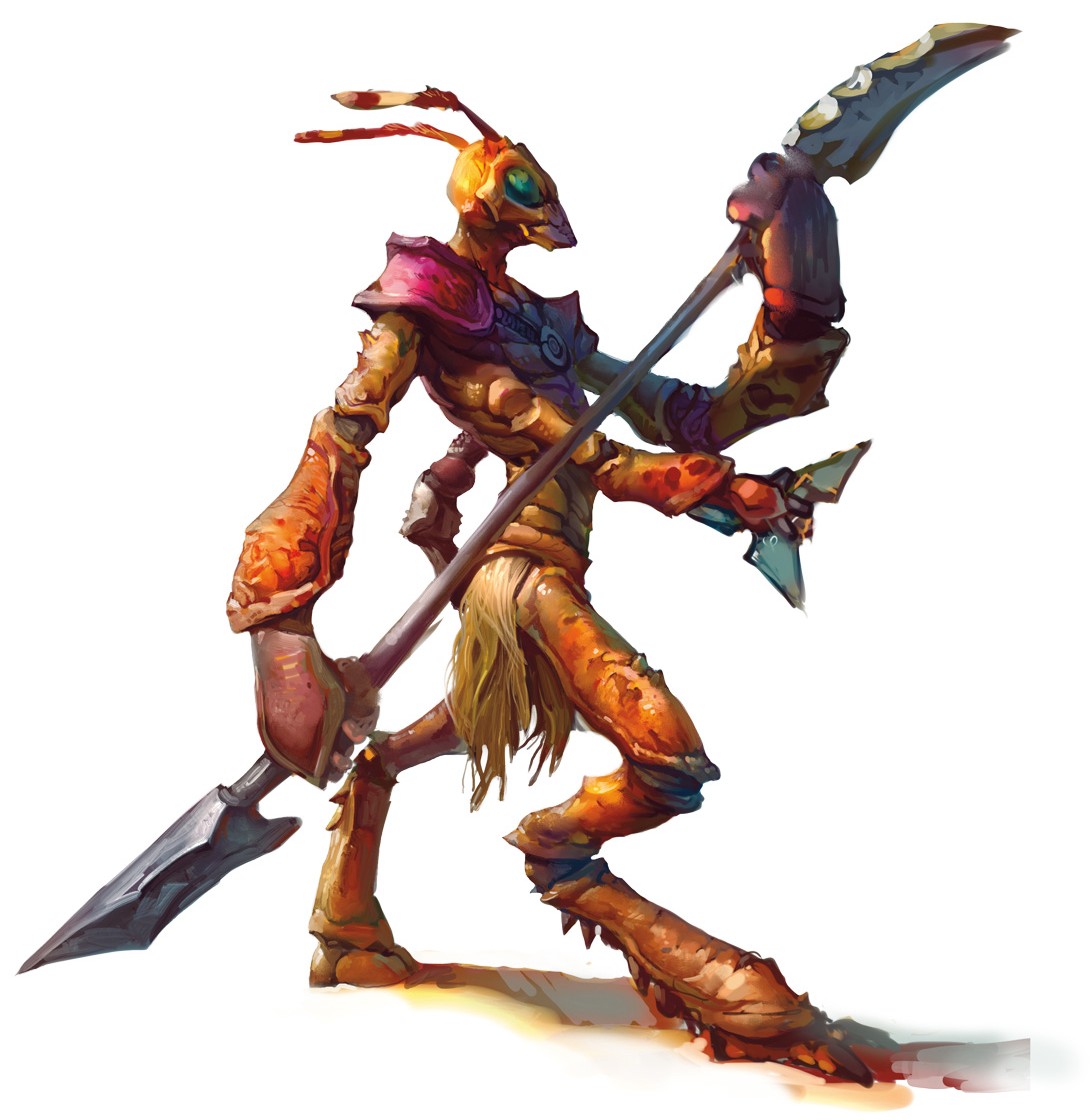D&D Monster Spotlight: The Thri-Kreen


From the wastes of Athas to the Character Optimization Boards, nobody is as well-armed as the Thri-Kreen.
Thri-Kreen are a storied part of D&D’s history. Most at home on the dying world of Athas, these six-limbed mantis-men have worked their way into the annals of D&D lore, first as the master trackers, gladiators, and assassins of Athas, and then later as one of those races you’d use in incredibly optimized builds that would let players attack 16ish times per round, dealing hundreds of damage in a single round, not accounting for criticals, and requiring players to roll hundreds of d6, theoretically. I never knew anyone that actually played one of those builds–but they’re out there.
And with Dark Sun looming on the horizon, it’s time to fetch the Thri-Kreen out of their desert homes, to dredge up the archived optimization boards, and bring the Thri-Kreen into the spotlight.
The Thri-Kreen first appeared in a set of DM accessories known as Monster Cards. Each one came with a suite of monsters that were double sided, giving DMs a full-color illustration on one side and the stats and combat info on the other. Here, the Thri-Kreen show up as a race of carnivorous insect men.
Now this is well before they had set foot into the burning wastes of Athas (which wouldn’t come out for another nine years),but they do have the iconic weapons, which I had heretofore thought were the creation of Dark Sun–but here we see the “small triangular ‘throwing wedge’ card from a hard crystalline substance” and their bladed polearm that would become the chatkcha and gythka later on. They also start life with their iconic 4 attacks plus paralyzing bite–and from this accessory a mythology would later be born.
The First Edition Thri-Kreen are basically a direct port in from the Monster Cards. They made the leap from accessory to the Monster Manual 2, where they appeared along side the Thessalhydra and the Thunder Beast, who will definitely be showing back up later on.
But Second Edition is where the Thri-Kreen really come into their own. They appeared in the Monstrous Compendium for Forgotten Realms and then also in the Monstrous Manual. Here they got more backstory and ecology. Now instead of just being carnivorous mantids, they are nomadic insects–and you can tell from the artwork that they’re much more mantis-like than humanoid–and they are bigger too, standing at 7 feet tall and 11 feet long.
In 2nd, the Thri-Kreen weapons gain their signature name (and do a little more damage as well, interestingly enough dealing more damage to larger than man-sized targets). They also gain some signature maneuvers that they can use, including a sudden leap that allows them to cover great distances, the ability to develop psionics. Already some pretty substantive changes.
But–the other major change that 2nd Edition brought with it is Dark Sun. Here the Thri-Kreen were more like thrive-kreen. They became an enduring part of the setting, fitting right in to the barbaric savagery that populated most of Athas. With their multiple attacks and penchant for wild psionics, the Thri-Kreen carved out a niche in the desert world of Athas, where they were notorious hunters and gladiators–they had their own supplement:
And they also became player races in this edition, first in the infamous Player’s Option: Skills and Powers where they lent their signature powers to players. This, coupled with their multiple natural attacks and ability to advance to level 16 as a Fighter (most other monstrous races are capped at 12), made them a popular choice. Later in the Expanded and Revised Dark Sun they got a little more character. Thri-kreen adopt their companions as a pack–all thri-kreen have a sort of protective pack mentality.
In Dark Sun we get a better look at the Thri-Kreen as nomadic hunters. They are driven by the need to understand their own place in the world, they don’t have permanent communities, instead moving from place to place, hunting the game they need to survive (which can include humanoids, elves in particular), and then moving on before they deplete the area. We also learn they never sleep in this edition as well–they only live 30 years, but it is 30 years of constant activity. Not a single moment is idle.
The other thing we get in 2nd Edition is variety as well. Dark Sun introduces the Tohr-Kreen, or Noble thri-kreen as they are called by nonkreen. The tohr-kreen are larger, more cultured, civilized version of the thri-kreen. They are more intelligent and deadly than their brethren, possessing new weapons like the kyorkcha (which is an upgraded chatkcha) and fight with more powerful versions of thri-kreen weaponry.
But in addition to being more deadly, they are much more civilized as we said. They have a taste for the finer things in life–they purchase artwork, they are rumored to have a massive city somewhere, beyond the endless sands of Athas, and they in general are a little more refined than their brethren. Mysterious lone wanderers, the tohr-kreen make excellent allies, or, if you decide to go against these magnificent mantids, they also make fantastic great helms if you want to hollow out their skull.
But it wouldn’t be 2nd Edition if we didn’t touch on Spelljammer. That’s right, the thri-kreen get their own spacefaring variant as well, the Xixchil. These are the artisans and crafters of the kreen. They are spacefarers and innovators and masterful surgeons. This latter part is especially important, because they are also at home in a cyberpunk setting–they will routinely remove a limb and replace it with a “modification” be it a weapon limb, or some other upgrade to themselves. They are driven to explore so that they can find places to upgrade whatever species they come across.
Xixchil have been known to upgrade creatures–they have given wings to humans, they have created implanted dagger throwers into arms, they created a headless dwarf with super strength, aor special limbs that let them deal extra damage–and even get extra attacks. So, cybernetically augmented insectmen. In space.
Third Edition was also very good to the Thri-Kreen. They become much more humoanoid (as seen above), but retain much of what characterizes them, including innate psionics, a paralysis bite, and multiple weapon fighting. This last one is the biggest one for this edition. 3.x was all about leveraging iterative attacks–well, okay, 3.x was really about playing a Wizard and being better than every class at their own game. Especially the ones you’d think a Wizard wouldn’t be very good at. But the rules for multiple attacks really blossomed in 3.x, and the thri-kreen were poised to take massive advantage of this.
Especially the way that multiweapon fighting worked. This meant that you could see builds that had 16 or more attacks pretty regularly, especially once Savage Species came out and even more multiweapon fighting feats came out. One of the baseline sort of jumping-off points does like 120d6+285 damage per full attack action (assuming that every attack hits). And that’s on the low end of the ridiculous spectrum.
And that’s before they were a playable class in the Complete Psionic. 3.x man, that edition had its problems. And playing a Thri-Kreen thri-kreen was one of them.
4th Edition added its own spin to the thri-kreen. They became more spiritual in 4th Edition, revering the primal spirit Old Grandfather, whom they called the Sand Father–and in the sands of the world, they dwelled respecting their place within it. They are powerful primal and psionic creatures, who take on the roles of rugged survivors who gain strength from their struggles, and who protect the lands they consider theirs.
Gamewise, they had a few different variants, there was the Ambusher, which would daze creatures and attack before springing into shadows. The Scout which was a highly mobile combatant, and finally the Desert Talker who would command the sands themselves and were one of the stronger Controller types, in that they were good at actually controlling their opponents.
Finally there’s 5th Edition. And, of the “humanoid” Thri-Kreen I think I like this version the most. Though I still prefer the 2nd Edition aesthetic of all–but, these guys are characterized again as wanderers and isolationists. They retain some of the 2nd Edition traits, including a taste for elves, and a pack mentality–but they are a little more utilitarian. They attack for food, not just because they can. They have difficulty communicating in nonkreen languages, speaking nonverbally exclusively. They might draw or create some other kind of pictures instead.
All thri-kreen become chameleonic, and they can still do their massive leaps and their paralyzing bite, but they only make one claw attack normally. Even the optional variants who employ the Gythka–which, let’s reflect on the disappointing change to the blade up there–only make two attacks with their multiattack abilities. Their psionics are pretty potent, enabling them to defend themselves a little better.
The thri-kreen are an interesting race, and it feels like there’s a niche that they have yet to expand into–I’m hoping that whenever we see more of Dark Sun in 5th Edition, we see more of these sleepless wanderers, warriors, mystics, and friends.
Happy Adventuring!

